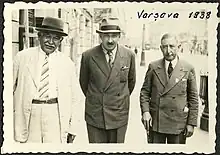Ayaz İshaki
Möxəmmətğayaz Ğiləcetdin ulı İsxaqi,[2] in Turkish: Muhammed Ayaz İshaki[3] (10 February 1878 — 22 July 1954) was a leading figure of the Tatar national movement, author, journalist, publisher and politician.[4] The importance of İshaki to Tatar literature has been compared to what Pushkin and Tolstoy are to Russians. The most known story of İshaki's is the dystopian 200 yıldan soñ inqiraz ("Extinction in 200 years"). Among the plays often revered is Zöləyxa (1917), which focuses on forced baptism of his people.[5][6]
Ayaz İshaki | |
|---|---|
عیاض اسحاقی Гаяз Исхакый Ğayaz İsxaqi | |
.jpg.webp) | |
| Born | Möxämmätğayaz İsxaqi (İsxaqov) 10 February 1878 |
| Died | 22 July 1954 (aged 76) Turkey |
| Other names | Muhammed Ayaz İshakî İdilli[1] |
| Relatives | Saadet Çağatay (daughter) |
Based on his early writings, İshaki, who was aligned more with the Jadids and didn't follow the traditional route of becoming a Mullah, felt that the so called national problem of the Tatars was also largely their own fault; .."[a people] threatened with complete extinction due to their reluctance to follow progress, the Russian culture and renew their centuries-old customs". According to researcher Azat Akhunov, İshaki believed that the progress of the Tatar nation was possible only in close cooperation with the Russian world, primarily its enlightened part. While living in İstanbul, İshaki actively corresponded with Maxim Gorky, who wanted to translate his works into Russian.[6]
Ayaz İshaki's daughter was the Turkologist Saadet Çağatay.[7]
Biography
İsxaqi[8] (Ishakhov) was born in 1878 in the village of Yaushirma near Kazan to a Mishar Tatar parents, father Ğiläcetdin and mother Qamäriyä.[9] İshaki was home-schooled by his father at an early age and was sent to study in a madrasah (religious school). He continued his education in the Russian-Tatar teachers' school (1898–1902).
İshaki moved to Kazan in 1904, where he became acquainted to socialists and adopted some of their views. He became involved in revolutionary activities, participated in an all-Muslim congress in 1905[10] and subsequently was arrested and sent to a prison near the city of Arkhangelsk in northern Russia in 1907.

After the February Revolution of 1917 he was involved in activities aimed at achieving cultural autonomy for the Volga Tatars and other Turkic peoples of Russia. As a result of his activities, the Soviet authorities started a campaign of harassment and persecution against him and his associates. He was forced to emigrate in 1920. After settling in Germany, İshaki started publishing a Tatar-language magazine Milli Yul ("The Way of the Nation") in 1928.[11] In 1931 he presided over the Independence Committee of the Muslims in Idel Ural.[10]
In 1939 the magazine was closed and İshaki decided to immigrate to Turkey. After World War II he became involved in political activities. At this stage his main goal was the restoration of the Tatar nationhood lost in 1552 when the Kazan Khanate was defeated and occupied by the Moscow Principality.
Throughout his life İshaki traveled to Poland, Germany, Japan, China and Turkey where he tried to establish Tatar-language press and unite disparate Tatar émigré communities. In Finland he spent time especially among the Tatar community of Tampere during 1930s. When İshaki organized a memorial service for Idel-Ural State in Warsaw, a few Finnish Tatars took part; among them Aisa Hakimcan and Gibadulla Murtasin.[12]
Ayaz İshaki died in 1954 and was buried in Edirnekapı graveyard of Istanbul.
Notes
Bibliography
- İsxaqıy, Ğayaz. Äsärlär unbiş tomda. Edited by M. Kh. (Mansur Khasanovich) Khasanov. Kazan: Tatarstan kitap näşriäte, 1998.
- Kamaliyeva, Alsu. Romantik Milliyetçi Ayaz İshakî. Ankara: Yayınları, 2009.
- Muhammed Ayaz İshaki: Hayatı Ve Faaliyeti, 100. Doğum Yılı Dolayısıyla. Ankara: Ayyıldız Matbaası, 1979.
- Säxapov, Äxmät. Ğayaz İsxaqıy : načalny etap tvorčestva : monografija. Kazań: Master Line, 2003.
- ———. İshaki i tatarskaja literatura XX veka. Kazań: PIK Dom Piečati, 2003.
- Ахунов, Азат М. “Гаяз Исхаки «Кто он? Кто он, кто нашу нацию взрастил?»." Татарский мир, 2004, №3. https://web.archive.org/web/20180322003928/http://www.tatworld.ru/article.shtml?article=489§ion=0&heading=0.
- Сахапов, Минахмет Ж. Золотая эпоха татарского ренессанса. Казань: Таткнигиздат, 2004.
References
- https://islamansiklopedisi.org.tr/idilli-muhammed-ayaz-ishaki
- "Исхакый Гаяз".
- "Muhammed Ayaz İshaki (İdilli)".
- Sakhapov, Minakhmet Zh. (2004). Золотая эпоха татарского ренессанса. Kazan: Таткнигиздат. ISBN 5-298-04063-2.
- "Гаяз Исхаки: шакирдские будни, развод и политическая опала в жизни и творчестве".
- Akhunov, Azat. "Гаяз Исхаки «Кто он? Кто он, кто нашу нацию взрастил?»".
- "Prof. Dr. Saadet Çağatay Hayatı ve Eserleri".
- "Ğayaz İsxaqi (Гаяз Исхакый)".
- "Ğayaz İsxaqi (Гаяз Исхакый)".
- Landau, Jacob M. (1981). Pan-Turkism in Turkey. London: C. Hurst & Company. p. 81. ISBN 0905838572.
- "Von Sonnennschirmen und Wilden Horden". Berliner Blätter. Ethnographische und Ethnologische Beiträge (in German). LIT Verlag Münster: 87. ISSN 1434-0542.
- Muazzez Baibulat: Tampereen Islamilainen Seurakunta: Juuret ja Historia, pp. 100, 114. Gummerus Kirjapaino Oy, 2004. ISBN 952-91-6753-9.